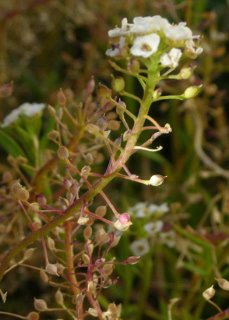 What’s blooming in the area: If anything’s still blooming, it’s in some protected place hidden from the road. One man burned piles of weeds Saturday; most have left things as they are.
What’s blooming in the area: If anything’s still blooming, it’s in some protected place hidden from the road. One man burned piles of weeds Saturday; most have left things as they are.What’s blooming in my garden: Chrysanthemums, sweet alyssum, one blanket flower, single flower atop a yellow snapdragon spike.
Animal sightings: Flock of nondescript, middling small birds looked like clothes pins on power line last Sunday. During week, I scared up groups of birds from Maximilian sunflowers in mornings. Horses in village.
Weather: Frost Monday morning killed any remaining f lowers; rest of week, sunny, cool and dry. Last noticeable rain, 15 October.
Weekly update: Mustard is one of the first plants to arrive in spring, and one of the last to depart come fall.
Tansy mustard (Descurainia Pinnata) emerges the end of March and puts out its feeble, yellow-green flowers a month later. I yank the distinctive grey-green plants when they emerge along the retaining wall, So far, the southwestern native hasn’t found favorable conditions in the yard. It remains a harbinger, not a nuisance.
Tumble mustard (Sisymbrium Altissimum) is more attractive when it takes over fields and roadsides in mid-May. Fortunately, the invasive annual hasn’t appeared here yet, but the clear yellow flowers continued in my uphill neighbor’s yard until August, producing pregnant seed pods. Its early rosette, similar to a thistle, is easy to identify, and so it should be possible to keep it at bay if it threatens to migrate.
With so many unwanted volunteers from the Cruciferae family, you’d think Sweet Alyssum would be a natural in my alkaline, clay loam. Not so.
When I first tried, soon after moving here, the bedding plants died the day I transplanted them, the seed disappeared. I dropped seed in pots on my back porch with morning glories. They bloomed just enough to continue buying them, even though the tiny seedlings drowned when I watered them, then died when the summer sun no longer reached them.
Two years ago, I noticed morning glory seeds had blown over the retaining wall and deposited themselves where the tansy mustard grew. Last year, I broadcast the cayenne-colored, oleaginous seeds there, then got impatient, and added plants. They both did so well the flowers survived the mild autumn until after Thanksgiving.
This year, I scattered Carpet of Snow on half-day snow March 13. I bought packs of New Carpet of Snow April 15, then added leftover generic seed from 2005 on April 22. Seedlings started blooming June 24.
Plants and seeds of Lobularia maritima behave differently. Breeders select varieties which retain their compact habit, and probably use techniques that encourage flowers and discourage stems. The seeds I use are the older, leggier versions that quickly form long stems with small flower heads. Many side branches remain from departed seeds that resemble utility pole cleats.
They looked good in spring before anything else was blooming, then got messy when bare, colorless stems dominated the mats of white flowers. By then, I didn’t care because there were so many other things to see, I could afford to let them be. This year, as the cool season dragged on, even the bedding selections elongated. But still I didn’t care because the nearby marigolds were spectacular. The kelly green leaves masked dry, bare ground, and occasionally the sweet scent could be detected on damp mornings.
Now they’re all that’s left. In November you ask very little of a flower that blooms this late. They may be native perennials along the Mediterranean, but here they'll die when temperatures fall below their zone 7 tolerance. Until then, they repay benign neglect with endurance.
No comments:
Post a Comment